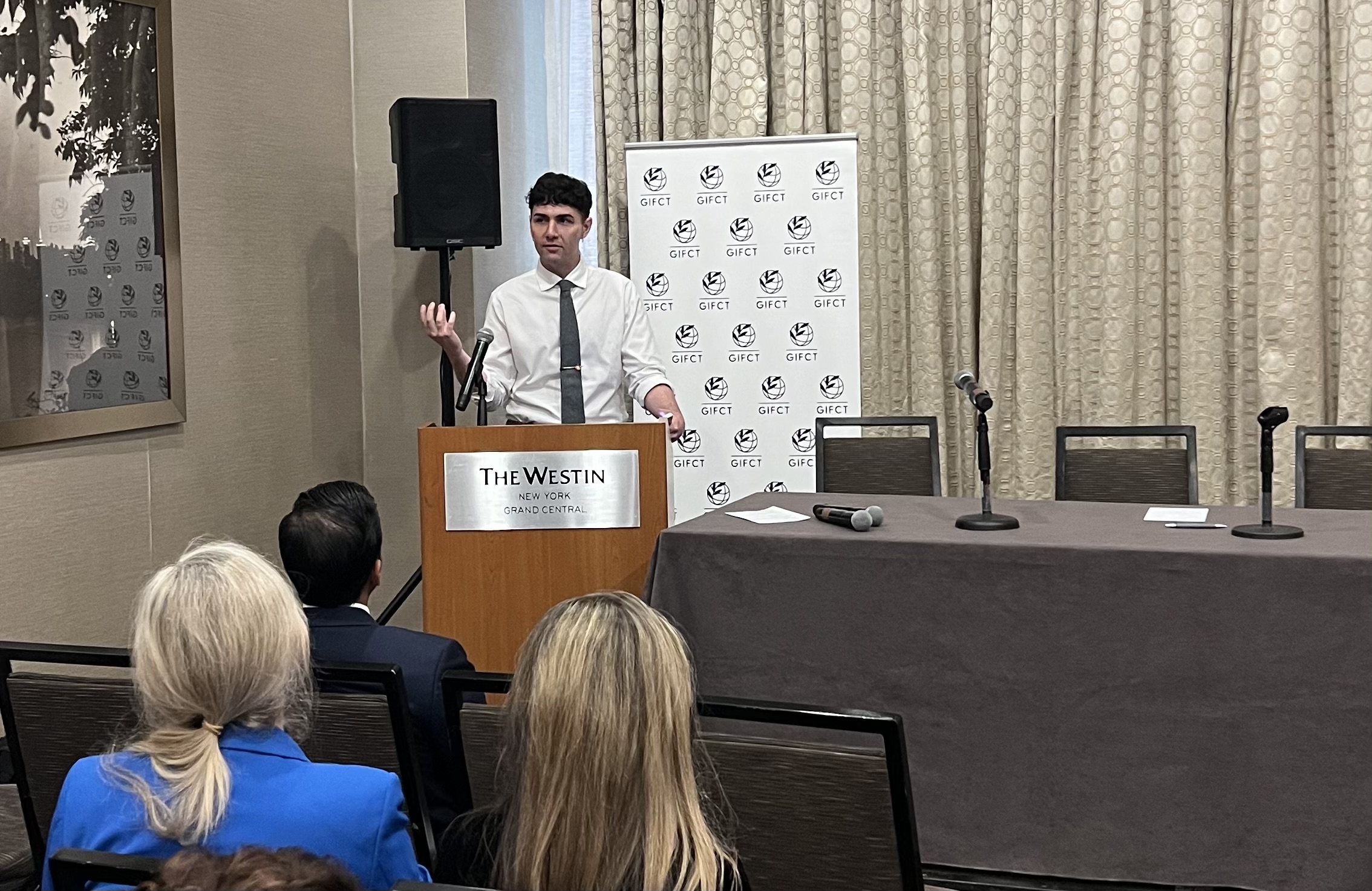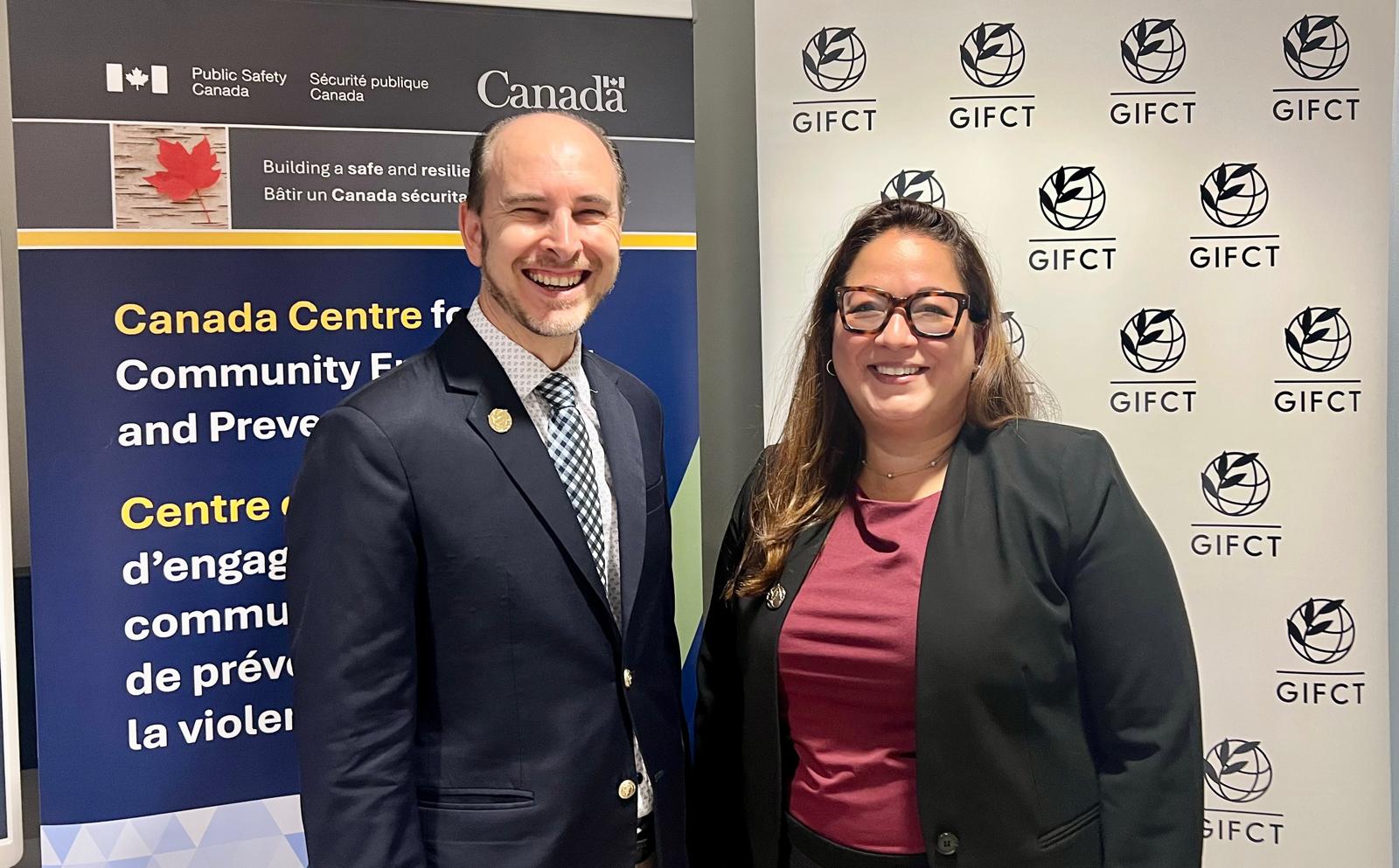September 24, 2025 / New York, USA – The Global Internet Forum to Counter Terrorism (GIFCT), in coordination with the United Nations Counter-Terrorism Committee Executive Directorate (CTED), convened leading representatives from industry, government, academia, and civil society for an event to strengthen collective efforts to address the evolving ways in which terrorists and violent extremists (TVEs) target children and youth, both online and offline. This event took place on the margins of the opening of the 80th UN General Assembly (UNGA) session, and aimed to foster an exchange of insights, lessons learned, and good practices learned from diverse fields, including safeguarding children online, trust and safety, counterterrorism, and the protection of children in armed conflict.
Rewriting the Playbook: Online Subcultures, Child Exploitation, and the Shifting Landscape of Terrorism
Welcome remarks by GIFCT Executive Director Naureen Chowdhury Fink and UN Assistant Secretary-General and CTED Executive Director Natalia Gherman highlighted the importance of multi-stakeholder approaches in countering the threats posed by adversaries across the ever-evolving threat landscape, as well as identifying lessons learned from the solutions and innovations developed in this space.

Opening remarks from GIFCT Executive Director Naureen Chowdhury Fink and UN Assistant Secretary-General and CTED Executive Director Natalia Gherman
“The threat picture can look dire, but our expanded community of GIFCT members and cross-sector stakeholders continues to work on solutions, innovations, and new approaches to ensure that emerging technologies are optimized to protect young people. Now more than ever, the offline and online worlds are deeply intertwined—not only in threats and challenges, but also in opportunities to build a safer, more resilient internet for all. Cross-sector knowledge sharing and lessons learned are therefore critical to developing a 360-degree understanding of threats, drawing insights from related fields, and creating comprehensive solutions.” – Naureen Chowdhury Fink, GIFCT
In opening remarks, Naureen Fink emphasized how the online and offline dimensions of radicalization are increasingly intertwined, with extremist subcultures converging across multiple platforms. TVE actors, she noted, continue to exploit the vulnerabilities and grievances of young people, weaponizing child exploitation as part of a hybridized, transnational threat. There was much to learn from industry, she noted, while also underlying the critical need to continue investing in safer offline environments for young people and addressing the conditions conducive to the spread of terrorism, as highlighted by the UN Global Counterterrorism Strategy.
While the exploitation of children by terrorist groups is not new, it is growing in both scale and sophistication, said Natalia Gherman. What unfolds in gaming, social media, and online subcultures, she warned, translates directly into offline harm—yet current frameworks often fail to capture these evolving tactics or the full spectrum of targeted vulnerabilities. The framing remarks of both speakers stressed that countering these threats requires collaboration across sectors, drawing on diverse expertise to build a fuller understanding of the challenge while safeguarding the rights extremists seek to erode.
Fireside Chat: The Evolution of Industry Approaches to Diverse Harms Types
For the first session, GIFCT Executive Director Naureen Chowdhury Fink moderated a “fireside chat,” which brought together GIFCT’s current and forthcoming Operating Board Chairs, YouTube and Meta, respectively, with the head of the Tech Coalition for a high-level discussion on tackling intersections of child harms and terrorism online, identifying industry solutions and areas of potential convergence. Speakers stressed that child sexual abuse material (CSAM) and terrorist/violent extremist content (TVEC)—long treated separately—now overlap more often, demanding coordinated, cross-sector responses. Industry tools and resources, like hash-sharing and intelligence desks, remain critical, but efforts must extend beyond existing strategies to fully address these harms, the panelists explained.

Fireside Chat: The Evolution of Industry Approaches to Diverse Harms Types
“It is only through initiatives like GIFCT, where we convene stakeholders from across sectors, can we attempt to understand and respond to these ever-changing threats. This nexus of harm types – where youth and terrorism intersect – is a critical space for GIFCT and its partners to focus their collective efforts.” – Leslie Miller, YouTube
The speed of adversary adaptation in the face of counterterrorism measures and the need to move beyond siloed moderation were underscored throughout the session. Several tools were highlighted during this session, including industry efforts to develop age-appropriate access, using intelligence-led monitoring of behavioral signals, and developing tools like Lantern and the hash-sharing database to foster cross-platform collaboration. Speakers emphasized the importance of broader coalition engagement, increased public awareness, and targeted yet scalable action to protect children and vulnerable communities.
Terrorism and Child Exploitation: A Convergence of Threats
GIFCT’s Senior Director of Memberships and Programs, Erin Saltman, moderated a panel featuring perspectives from UNICEF, the European Union, the Federal Bureau of Investigation, and Discord. Speakers noted that violent actors had long exploited children in conflict zones and were now doing so online, forcing practitioners to cross institutional silos and collaborate across disciplines. These dynamics have also led the tech sector to think more about behavioral signals, they underscored. Reflecting on histories of dealing with children in contexts of armed conflict and violence, one speaker stressed the importance of remembering that children must always be considered victims, warning that punitive approaches risk deepening harm. Europe’s rising struggle with this threat nexus was highlighted, and it was explained how laws like the EU’s one-hour takedown rule must be paired with robust cross-sector collaboration to leverage the agility and resources of tech platforms.

Terrorism and Child Exploitation: A Convergence of Threats
“We know that young people are increasingly drawn to ideologies rooted in terrorism and violent extremism, and that young people across Europe and around the world are not only consuming this content, but in some cases are being mobilized in offline ways. The focus of this work is increasingly shifting to younger, vulnerable communities, but we must always remember that impacted children are victims above all else.” – Bartjan Wegter, European Union
Hybrid networks blending CSAM, gore, and other sadistic content, have forced federal law-enforcement initiatives to blend counterterrorism and child protection expertise to disrupt these threats, breaking traditional institutional silos. Industry actors highlighted violent extremist subcultures’ use of desensitization and coercion to pull youth into closed networks; in response, the tech industry continues to develop new policies that are fostering friction-based interventions and detection models aimed at disrupting exploitation and redirecting users, they noted. Panelists closed with a call for coordinated, victim-centered strategies spanning governments, civil society, and industry to shield children against an evolving threat landscape.
Managing Evolving Harms: An Update of GIFCT’s Incident Response Framework
GIFCT officially launched the updated Incident Response Framework (IRF) on the margins of the 80th UNGA. GIFCT Director of Trust and Safety Solutions Skip Gilmour briefed the audience on the new features and parameters, designed to enhance rapid and coordinated responses to terrorist and mass violence events with significant online dimensions. Developed through extensive consultation with government, civil society, and the tech sector, the revised framework includes new communication protocols and an execution-oriented activation structure designed to support GIFCT’s expanded and diversified membership and stakeholder community.

Managing Evolving Harms: An Update of GIFCT’s Incident Response Framework
“The revised IRF was shaped through an independent review and multistakeholder collaboration across industries. It gives GIFCT and its members the tools to respond quickly and effectively to offline events with information sharing, streamlined communication, and tailored support—all while improving transparency and maximizing member benefit.” – Skip Gilmour, GIFCT
Collaborative Interventions: Countering New Threats With Cross-Sector Solutions
The final session of the day, moderated by CTED Legal Officer Aleksandra Dier, included senior representatives from CTED, the Authority of Terrorist Content Online and Child Sexual Abuse Material Authority, the AU-EU Youth Lab, Mythos Labs, and the Violence Prevention Network. Panelists explored how multistakeholder collaboration and innovative interventions can address the hybridization of harms affecting children and youth. Speakers underscored the importance of building taxonomies and support networks to help practitioners make sense of signals and share insights across sectors, while another point highlighted the critical role of youth engagement and enhancing youth resilience in offline and online communities – an example of such work are the AU-EU Youth Lab grants, which fund young people leading deradicalization work in conflict-affected communities.
As the online and offline worlds become increasingly interconnected, examining the role of technology and innovation in prevention is a crucial step in empowering practitioners. Mythos Labs’ AI-powered tool, Aldous, supports deradicalization efforts through AI chatbot conversations with at-risk individuals and tailors psychosocial interventions, but integrating offline prevention and deradicalization interventions into the broader strategy for maximum impact was recognized as being equally important.

Collaborative Interventions: Countering New Threats With Cross-Sector Solutions
“The global nature of GIFCT ensures that stakeholders across platforms, time zones, and threat landscapes can work together to address harms that so often span both online and offline spaces. To effectively respond, prevention interventions and deradicalization initiatives must be part of this collective effort—collaboration across every level is key to meeting these evolving challenges.” – Jonathan Russell, Violence Prevention Network and Chair of GIFCT’s Independent Advisory Committee
Panelists cautioned that while cross-sector solutions are indeed valuable, child exploitation in the terrorism context remains a new and sensitive area, requiring careful adaptation of tools and frameworks. Together, the discussion reinforced that prevention cannot be confined to either online or offline spaces; coordinated, human rights–based approaches across governments, civil society, and industry are essential to keeping pace with these harms.
Key Findings and Next Steps
The day’s discussions underscored how TVEs are increasingly targeting children and youth through hybridized tactics that blend online subcultures, CSAM, and TVEC. This convergence of harms has made cross-sector collaboration more critical than ever. Speakers repeatedly emphasized that children must be treated first and foremost as victims, warning that punitive approaches risk amplifying harm rather than preventing it.
Across panels, industry representatives highlighted how tools originally designed for each of these harm types remain essential, yet adversaries continue to adapt quickly, highlighting the need to move beyond reactive moderation and toward upstream safeguards, proactive prevention, and stronger links between online detection and offline intervention.
Throughout the event, a consistent message emerged: protecting children demands strategies that bridge online and offline spaces, remain rooted in human rights, and unite governments, civil society, law enforcement, and industry in coordinated, comprehensive action.
GIFCT partners with Public Safety Canada and CTED
GIFCT was also honored to co-host a closed-door roundtable event with Public Safety Canada (PSC) and CTED, which focused on practitioner and industry experiences, lessons learned, and recommendations related to developing prevention interventions for countering the radicalization and exploitation of youth online. Opening remarks by PSC Executive Director Robert Burley, GIFCT Executive Director Naureen Chowdhury Fink, and CTED Director and Chief of Branch, David Scharia were followed by discussions moderated by Naureen Fink and CTED Section Chief Elizabeth Joyce.

PSC Executive Director Robert Burley and GIFCT Executive Director Naureen Chowdhury Fink
The event brought together experts from industry, civil society, and government for an opportunity to understand some of the challenges, needs, and good practices developed by frontline actors working with youth. Speakers shared experiences, programs, and approaches in identifying and managing risk, and highlighted the critical needs for greater collaboration and sharing between sectors, in line with human rights and privacy obligations.
We are grateful to our partners and participants for their contributions and for the opportunity to join these collaborative, impactful sessions, and to CTED for hosting us at their office. We are proud to support work that seeks to improve online safety for all and look forward to taking these discussions forward.
GIFCT Participation in Wider UNGA Side Events
Each year, the UN General Assembly meetings provide a unique opportunity for global partners to gather, brief one another on progress, identify evolving threats and trends, and plan future partnership opportunities. GIFCT was delighted to attend and participate in side events relevant to our mission of preventing terrorists and violent extremists from exploiting digital platforms. This year, GIFCT was honored to participate in convenings hosted by the Tech Coalition, the Christchurch Call Foundation, the Global Centre, and by our members Meta, Microsoft, and TikTok.
Related Research and Analysis
As an extension of the discussions that occurred during the event, please see the following collection of expert Insights related to the intersection of terrorism, violent extremism, and child exploitation from our academic research wing, the Global Network on Extremism and Technology (GNET).
View Insights PDF



